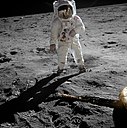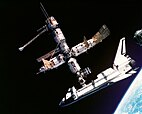| Part of a series on |
| Spaceflight |
|---|
 |
|
|
The Space Race (Russian: Космическая гонка [kɐsˈmʲitɕɪskəjə ˈɡonkə]) was a 20th-century competition between two Cold War rivals, the United States and the Soviet Union, to achieve superior spaceflight capability. It had its origins in the ballistic missile-based nuclear arms race between the two nations following World War II and had its peak with the more particular Moon Race to land on the Moon between the US moonshot and Soviet moonshot programs. The technological advantage demonstrated by spaceflight achievement was seen as necessary for national security and became part of the symbolism and ideology of the time. The Space Race brought pioneering launches of artificial satellites, robotic space probes to the Moon, Venus, and Mars, and human spaceflight in low Earth orbit and ultimately to the Moon.[1]
Public interest in space travel originated in the 1951 publication of a Soviet youth magazine and was promptly picked up by US magazines.[2] The competition began on July 30, 1955, when the United States announced its intent to launch artificial satellites for the International Geophysical Year. Four days later, the Soviet Union responded by declaring they would also launch a satellite "in the near future". The launching of satellites was enabled by developments in ballistic missile capabilities since the end of World War II.[3] The competition gained Western public attention with the "Sputnik crisis", when the USSR achieved the first successful satellite launch, Sputnik 1, on October 4, 1957. It gained momentum when the USSR sent the first human, Yuri Gagarin, into space with the orbital flight of Vostok 1 on April 12, 1961. These were followed by a string of other firsts achieved by the Soviets over the next few years.[4]
Gagarin's flight led US president John F. Kennedy to raise the stakes on May 25, 1961, by asking the US Congress to commit to the goal of "landing a man on the Moon and returning him safely to the Earth" before the end of the decade.[5] Both countries began developing super heavy-lift launch vehicles, with the US successfully deploying the Saturn V, which was large enough to send a three-person orbiter and two-person lander to the Moon. Kennedy's Moon landing goal was achieved in July 1969, with the flight of Apollo 11.[6][7][8] The conclusion of Apollo 11 is regarded by most as ending the Space Race with an American victory.[9] This view is contested by some historians,[10] whilst space historian Asif A. Siddiqi proposed a more balanced view.[11] The USSR continued to pursue crewed lunar programs to launch and land on the Moon before the US with its N1 rocket but did not succeed, and eventually canceled it to concentrate on Salyut, the first space station program, and the first landings on Venus and on Mars. Meanwhile, the US landed five more Apollo crews on the Moon[12] and continued exploration of other extraterrestrial bodies robotically.
A period of détente followed with the April 1972 agreement on a cooperative Apollo–Soyuz Test Project (ASTP), resulting in the July 1975 rendezvous in Earth orbit of a US astronaut crew with a Soviet cosmonaut crew and joint development of an international docking standard APAS-75. Being considered as the final act of the Space Race,[9] the competition was only gradually replaced with cooperation.[13] The collapse of the Soviet Union eventually allowed the US and the newly founded Russian Federation to end their Cold War competition also in space, by agreeing in 1993 on the Shuttle–Mir and International Space Station programs.[14][15]
- ^ "The Space Race". History.com. February 21, 2020. Retrieved January 8, 2023.
- ^ "How Did NASA'S "Vomit Comet" Get Its Name? A Brief History". gozerog.com. June 30, 2023. Retrieved August 1, 2023.
A Soviet youth magazine in 1951 is often credited with sparking public interest in space travel. Quickly picked up by US magazines, the idea of extending the Cold War playing board to outer space soon energized the imaginations of politicians, military leaders, and the private sector.
- ^ Schefter 1999, pp. 3–5.
- ^ Siddiqi 2003a, p. 460.
- ^ Cite error: The named reference
Special Messagewas invoked but never defined (see the help page). - ^ "Apollo 11 Command and Service Module (CSM)". NASA Space Science Data Coordinated Archive. Retrieved November 20, 2019.
- ^ "Apollo 11 Lunar Module / EASEP". NASA Space Science Data Coordinated Archive. Retrieved November 20, 2019.
- ^ "Apollo 11 Mission Summary". Smithsonian Air and Space Museum.
- ^ a b Both the Apollo 11 Moon landing and the ASTP have been identified as the end of the Space Race,Samuels, Richard J., ed. (2005). Encyclopedia of United States National Security (1st ed.). SAGE Publications. p. 669. ISBN 978-0-7619-2927-7.
Most observers felt that the U.S. moon landing ended the space race with a decisive American victory. […] The formal end of the space race occurred with the 1975 joint Apollo-Soyuz mission, in which U.S. and Soviet spacecraft docked, or joined, in orbit while their crews visited one another's craft and performed joint scientific experiments.
- ^ Frost, Jennifer (July 18, 2019). "Who really won the US-Soviet space race?". newsroom.co.nz. Retrieved January 25, 2024.
- ^ Cite error: The named reference
AASwas invoked but never defined (see the help page). - ^ Williams, David R. (December 11, 2003). "Apollo Landing Site Coordinates". NASA Space Science Data Coordinated Archive. NASA. Retrieved September 7, 2013.
- ^ U.S.-Soviet Cooperation in Space (PDF) (Report). US Congress, Office of Technology Assessment. July 1985. pp. 80–81. Retrieved June 13, 2018.
- ^ Boyle, Alan (March 23, 2001). "Russia bids farewell to Mir". NBC News. New York. Archived from the original on June 15, 2015. Retrieved June 13, 2015.
- ^ Garcia, Mark (April 30, 2015). "ISS Facts and Figures". International Space Station. NASA. Archived from the original on June 3, 2015. Retrieved June 13, 2015.



